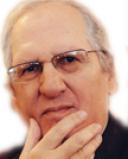
Some of you may be familiar with the film Bad Santa, starring Billy Bob Thornton. Compared to the following horrific case occurring just this past Christmas Eve, Billy Bob's character is a veritable Boy Scout. This is a tragic tale of a Santa gone beyond bad: an evil Santa.
Bruce Jeffrey Pardo, a forty-five-year-old, recently divorced, unemployed aerospace engineer with no known history of violence, allegedly killed nine people while dressed up in a Santa Claus suit on Christmas eve in Covina, a sleepy suburb of Los Angeles. According to news articles, he had lost his job six months ago and was apparently under intense financial pressure, made worse when ordered last week by a judge to pay ten-thousand dollars as part of his final divorce settlement to his wife, one of the victims. This may be the deadliest mass shooting of 2008 in the U.S., and is reminiscent for some Angelenos of the infamous Manson family massacre in death toll and sheer depravity.
Pardo had evidently agreed to act as an usher for Midnight Mass at the Holy Redeemer Catholic Church in his town of Montrose. Instead, he donned a Santa suit and arrived at the home of his ex-in-laws near midnight with a semi-automatic weapons and homemade flame-thrower in hand disguised as Christmas presents. The first thing he did was shoot an eight-year-old girl in the face as she excitedly greeted Santa at the door. Miraculously, she somehow survived. Then he allegedly shot and killed his ex-wife and her parents, and as many guests as he could before torching the house. The primary targets of his murderous rage were presumably his ex-wife and her immediate family, whose bodies, nine in all, were burnt beyond recognition in the fire that consumed their home. Dental records were needed to identify the dead. Pardo escaped the inferno, but was reportedly burnt so badly that despite having had a plan to flee to Iowa, he was found dead several hours later at his brother's home, a suicide.

According to the head usher at Pardo's church: "He was the nicest guy you could imagine. Always a pleasure to talk to, always a big smile." Other acquaintances reported no recent outward signs of instability or rage. This is not an unusual thing to hear from friends and family of mass murderers. And this is precisely the problem. What they see is a carefully maintained persona which conceals the festering rage within. The hidden shadow, as Jung called it. The demonic Mr. Hyde lurking beneath the civil veneer of the saintly Dr. Jekyll. The rage festers and becomes toxic exactly because it and its true source is not admitted and addressed openly. Instead, it is repressed or kept secret until violently acted upon. I have described this ostensibly spontaneous syndrome as a form of running amok. How long had Mr. Pardo been in this dangerous state of mind? And why had he not received any treatment? Or had he? This part of the story is still untold. It is not known at this time whether he had sought or received psychiatric treatment of any kind, though the divorce papers reportedly state that his marital problems were deemed irreconcilable and beyond the help of marital therapy. But even if he had been receiving treatment of some sort, could this tragedy have been prevented? Unfortunately, it would appear that despite being quite active in his church, Mr. Pardo's long-standing relationship to organized religion failed to provide sufficient support, succor or comfort in this case to stave off his demons. (See my previous post on spirituality and religion.) Would psychological treatment, meaning medication, psychotherapy or both, necessarily have fared any better in providing the sort of assistance required to avoid this disaster?
In today's depressed economy, job loss is surging while cost of living soars. This places significant financial pressures on people, which, when superimposed on an already unstable or emotionally fragile mental state, can push a person into destructive, evil deeds such as this. Frequently such evil deeds correspond to the finalization of a long, bitter divorce, as appears to be the case here. What a person in this predicament ( so like the character played by Michael Douglas in Joel Schumacher's brilliant and prescient film, Falling Down) needs is a way to have his or her rage acknowledged, understood, and accepted. And assistance in finding some way to deal with this rage more constructively, to channel or redirect it into constructive or creative activity. Merely counseling them to forgive and forget or to be more rational or just take their medication is futile. Such patients need more than medications, marital therapy or what is today generically called "anger management." Unfortunately, this increasingly pervasive problem of pathological rage is still one of the most difficult for psychiatry and psychology to deal with. Mere medication and/or cognitive- behavioral interventions are totally inadequate, as I discuss in detail in my book, Anger, Madness, and the Daimonic. How to deal properly with anger is the pivotal question. This hinges on better understanding anger's double-sided, daimonic nature. Until mental health professionals start to recognize and accept this serious challenge, we will sadly continue to see more of these sordid incidents as social, financial and interpersonal stressors run rampant.
The presumed perpetrator in this case appears to have had a slow, almost imperceptibly burning fuse. A fury stemming from a perfect storm of frustrating circumstances and painful losses. Resentment and anger had probably been building into rage, and, like the primitive flamethrower of compressed racing fuel he constructed, required only a tiny spark to set off a catastrophic conflagration. Ironically, as evil often does, when least expected. From a formerly loving, spiritual, law-abiding, jovial man turned evil, satanic Santa on a cold, dark Christmas Eve.


